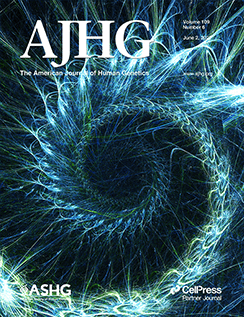先天性心脏侧边性缺陷的基因组罕见变异机制:一种遗传模型方法
IF 8.1
1区 生物学
Q1 GENETICS & HEREDITY
引用次数: 0
摘要
侧边性缺陷是由通常器官左右不对称的扰动所定义的。先天性心脏病(CHD)的遗传病因通常是未知的(不到40%),因此我们使用基因模型方法在临床诊断为侧侧缺陷的个体的外显子组/基因组测序(ES/GS)数据中鉴定已知侧侧缺陷相关基因(n = 115)的贡献变异。未解决的ES/GS数据分析来自三个冠心病队列:贝勒医学院-基因组学研究阐明罕见病遗传学(BCM-GREGoR;n= 251先证者ES), Gabriella Miller Kids First儿科研究项目(Kids First;n = 158三人组GS)和儿科心脏基因组学联盟(PCGC;n = 163 trio ES)。反杂合基因变异分别占2.8%(遗传基因变异占0.4%)、8.2%和13.5%;这显著高于千人基因组计划提供的602组对照三人组(p = 0.001, 1.4e - 07和8.9e - 13)。在Kids First和PCGC数据集中,分别有0.4%和1.4%的非侧边性冠心病患者存在反杂合基因变异,与对照组相比,差异无统计学意义(p = 1和0.059)。总的来说,在侧边队列中,23%的基因对具有相同的运动纤毛结构复合体。在侧侧性冠心病的39个独特基因对中,有29个更有可能成为DiGePred工具预测的潜在基因命中。这些发现提供了进一步的证据,遗传上位相互作用可能有助于侧侧缺陷的复杂遗传。本文章由计算机程序翻译,如有差异,请以英文原文为准。
Genomic rare variant mechanisms for congenital cardiac laterality defect: A digenic model approach
Laterality defects are defined by perturbations in the usual left-right asymmetry of organs. The genetic etiology that underlies congenital heart disease (CHD) is often unknown (less than 40%), so we used a digenic model approach for the identification of contributing variants in known laterality-defect-associated genes (n = 115) in the exome/genome sequencing (ES/GS) data from individuals with clinically diagnosed laterality defects. The unsolved ES/GS data were analyzed from three CHD cohorts: Baylor College of Medicine-Genomics Research to Elucidate the Genetics of Rare Diseases (BCM-GREGoR; n = 251 proband ES), Gabriella Miller Kids First Pediatric Research Program (Kids First; n = 158 trio GS), and Pediatric Cardiac Genomics Consortium (PCGC; n = 163 trio ES). trans -heterozygous digenic variants were identified in 2.8% (inherited digenic variants in 0.4%), 8.2%, and 13.5% of individuals, respectively; this was significantly higher than in 602 control trios provided by the 1000 Genomes Project (p = 0.001, 1.4e−07, and 8.9e−13, respectively). trans -heterozygous digenic variants were also identified in 0.4% and 1.4% of individuals with non-laterality CHD in Kids First and PCGC datasets, respectively, which was not statistically significant as compared to control trios (p = 1 and 0.059, respectively). Altogether, in laterality cohorts, 23% of digenic pairs were in the same structural complex of motile cilia. Out of 39 unique digenic pairs in laterality CHD, 29 are more likely to be potential digenic hits as predicted by the DiGePred tool. These findings provide further evidence that digenic epistatic interactions can contribute to the complex genetics of laterality defects.
求助全文
通过发布文献求助,成功后即可免费获取论文全文。
去求助
来源期刊
CiteScore
14.70
自引率
4.10%
发文量
185
审稿时长
1 months
期刊介绍:
The American Journal of Human Genetics (AJHG) is a monthly journal published by Cell Press, chosen by The American Society of Human Genetics (ASHG) as its premier publication starting from January 2008. AJHG represents Cell Press's first society-owned journal, and both ASHG and Cell Press anticipate significant synergies between AJHG content and that of other Cell Press titles.

 求助内容:
求助内容: 应助结果提醒方式:
应助结果提醒方式:


